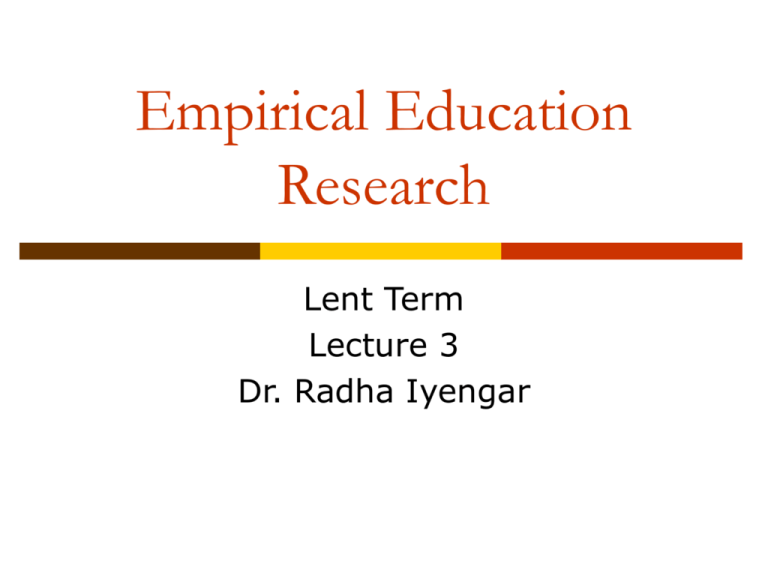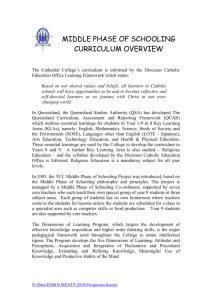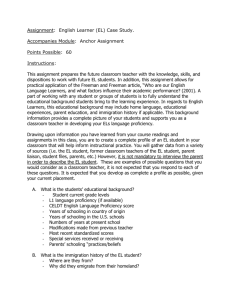E ist-1
advertisement

Empirical Education Research Lent Term Lecture 3 Dr. Radha Iyengar Last Time Model of Human Capital Acquisition Choose optimal schooling where MB=MC For some individuals, MC lower because of ability (ability bias) For some individuals, MB higher because of group/family factors (heterogeneity) IV estimates my be “unbiased” for a given subgroup but the returns in that subgroup may be very different than other groups Topics Covered Today Broadly 3 Major Strands of Empirical Research Returns to Education (Ability Bias) Credit Constraints and Education Investment Angrist and Krueger Ashenfelter and Rouse Carneiro and Heckman Dynarski Education Production Function Hanushek Krueger Hoxby Rouse and Figlio Estimating Returns to Education Generally 3 approaches: Cross-sectional variation (Mincer Regression) Within group differences Instrumental Variables Mincer Regression log( y ) = a + bS + cX + dX2 + e Estimated worldwide with estimates ranging from 0.05 to 0.15 Linear model fits the data well even in countries with very different economies, education system, etc. Source: Angrist and Lindhal (2001) JEL Issues with Mincer Regression How to interpret the coefficient on schooling? Ability bias: Upward “bias” Heterogeneity in effects: ??? Measurement Error: Downward “bias” Signalling vs. Human Capital (next week) In practice, OLS seems to be slightly, though not significantly smaller than the IV approaches Simple Solution to Ability Bias The simplest way of dealing with this problem is to find a measure of ability (IQ, AFQT, or similar) BUT no good reason to expect the relative ability bias to be constant across people This is especially a problem if b differs across ages and other groups Also the relationship between ability and schooling varies greatly across time and individuals. Instrumental Variables Basic goal: Find something that varies schooling but is uncorrelated with unobserved factors (e.g. ability) Estimate the component of schooling predicted by “instrument” Use predicted schooling (rather than actual schooling) to estimate relationship between schooling and earnings Various Instruments Card: Proximity to 2-Year or 4-Year colleges + Parent’s education Kane & Rouse: Tuition at local 2-year and 4-year colleges Angrist & Krueger: Quarter-of-birth and compulsory schooling laws Compulsory Schooling IV Angrist and Krueger (AK) use quarter of birth as an instrument for education to determine the impact of education on earnings. quarter of birth impacts education attainment b/c compulsory schooling laws, this source of schooling variation is uncorrelated with other factors influencing earnings, Does quarter of birth affect education? Regress de-trended education outcomes on quarter of birth dummy variables: ( Eicj Ecj ) 1Q1 2Q2 3Q3 ijc (individual i, cohort c, birth quarter j, education outcome E, birth quarter Q) This shows that Q does impact education outcomes such as total years of education and high school graduation. Is Schooling related to Quarter of Birth? Is this due to compulsory schooling laws?- 1 Indirect evidence: Examine impact of birth quarter on postsecondary outcomes that are not expected to be affected by compulsory schooling laws. No birth quarter impact on postsecondary outcomes is consistent with a theory that compulsory schooling laws are behind the birth quarter-education relationship for secondary education. Is this due to compulsory schooling laws?- 2 Direct evidence: Construct a difference-indifference measure of schooling law impact between high age requirement states and low age requirement states: Impact of Law [(% E age16, high % E age16,low ) (% E age15, high % E age15,low )] %Eage 16, high is the fraction of 16 year olds enrolled in high school in states where attendance in mandatory up to age 17 or 18) How to estimate: OLS Wald estimate compares the overall difference in education and earnings between Q1 and Q2-4 individuals Wald log WageQI log WageQII QIV EducQI EducQII QIV Consistency requires that the grouping variable (Q) is correlated with education (Educ), but uncorrelated with wage determinants other than education. For instance, this assumes that ability is distributed uniformly throughout the year. Difference-inDifferences estimate of about 4% Decreasing effect over time. Maybe because of increasing returns to college IV Estimates Two-Stage Least Squares (2SLS) uses quarter of birth to predict education, then regresses wage on this predicted value of education to estimate the return to education (ρ) First stage: E i X i C Yic c j Yic Qij jc i Second stage: log Wi X i C Yic c Ei i Correlation between QOB and Schooling IV Estimates of Return to Schooling Summary of AK Quarter of birth is a valid instrument: affects educational attainment through compulsory schooling laws, not through unobserved ability First quarter individuals (who enter school at an older age and can leave earlier too) receive about 0.1 fewer years of schooling and are 1.9% less likely to graduate from HS than those born in the fourth quarter. Quarter of birth is found to be unrelated to post-secondary educational outcomes. Between 10 to 33% of potential drop outs are kept in school due to compulsory attendance laws. Returns to an additional year of schooling are remarkably similar to those estimated with OLS, approximately 7.5% depending on the specification. What about variation in marginal benefits? Think that marginal benefits different for different people Want to see how shifts in marginal benefit curve affect investment in schooling Need assumption on how marginal benefits vary Within Family Estimates Some of the unobserved differences that bias a cross-sectional comparison of education and earnings are based on family characteristics Within families, these differences should be fixed. Observe multiple individuals with exactly the same family effect, then we could difference out the group effect Estimating Family Averages Can look at differences within family effect This of this as a different CEF for each family E[Yij -Yj | S, X, f] = a + b(Sij – Sj) + c(Xij – Xj) + c(X2ij – X2j) The way we estimate this: log( yij) aˆ bˆSij cˆXij dˆXij 2 fˆj eˆij What makes this believable No within family differences Might be a problem with siblings generally Parents invest differently Cohort related differences—influence siblings differently Different “inherited” endowment More believable with identical twins A twins sample Ashenfelter and Rouse (AR) Collect data at the Twins festival in Twinsburg Ohio Survey twins: Are you identical? If both say yes—then included Ever worked in past two years Earnings, education, and other characteristics Useful because also get two measures of shared characteristics, so can control for measurement error Comparing twins to others Sample at Twinsburg NOT a random sample of twins Benefit: more likely to be similar because attendees are into their “twinness” Cost: not necessarily generalizable, even to other twin Attendees select segment of the population Generally Richer, Whiter, More Educated, etc. Worry about heterogeneity of effects across some of these categories Where’s the variation Recall our estimating equation 2 ˆ ˆ log( yij) aˆ bSij cˆXij dXij fˆj eˆij If Sij is the same in both twins, no contribution to estimate of b Only estimated off of twins who are different from each other in schooling investments Correlation Matrix for Twins Education of twin 1, Education of twin 1, reported by twin1 reported by twin2 ALL of the identification for b comes from the 25% of twins who don’t have the same schooling Summary of AR Consistent with past literature—returns around 8-10 % OLS estimate slight upward bias but with measurement error there’s a slight downward bias Ability bias less of a problem than measurement error General Conclusions on RTS Returns appear to be between 8-12 percent in the US Not much different between OLS, IV, and within family estimators Maybe ability bias not as much of problem as we thought Maybe there’s an offsetting bias (marginal benefits, measurement error etc.) Maybe the estimation strategies are not eliminating the source of the bias—i.e. some other factor is affecting all these estimates. Credit Constraints and Education We’re always assuming selection into education (esp higher education) on ability but may also be on resources Can’t borrow against future earnings so if don’t have high asset endowment, hard to afford extra schooling References Carneiro and Heckman (2002) “The Evidence on credit constraints in Post-Secondary Schooling” Economic Journal 112: 705-734 Dynarski (2003) “Does Aid Matter: Measuring the Effect of Student Aid on College Completion” American Economic Review 93(1) % Attending College related to Parent’s Income How do Credit Constraints affect RTS Estimates? IV estimates of the wage returns to schooling (the Mincer coefficient) exceed least squares estimates (OLS) is consistent with short term credit constraints. The instruments used in the literature are invalid because they are uncorrelated with schooling or they are correlated with omitted abilities. Even granting the validity of the instruments, IV may exceed least squares estimates even if there are no short term credit constraints The Quality Margin The OLS-IV argument neglects the choice of quality of schooling. Constrained people may choose low quality schools and have lower estimated Mincer coefficients (‘rates of return’) and not higher ones. Accounting for quality, the instruments used in the literature are invalid because they are determinants of potential earnings. The general issue Individuals cannot offer their future earnings as collateral to finance current education Individuals from poorer families with limited access to credit will have more trouble raising funds to cover college This affects: Attendance in college Completion of college Quality/content of education Two theories for the facts Higher income parents produce higher “ability” children or invest more in their children Access to credit means low-income individuals don’t attend college, reducing their human capital and reinforcing the relationship between schooling and earnings Return to our model Let’s ignore experience (for ease) and so consider the model log( y ) Y a bS e Let’s also define the wages in for two groups: College Grad and HS Grads ln( y0 ) Y 0 attendance: 0 U 0 ln( y1 ) decision Y 1 1 Urule 1 specific on college S = 1 if Y1 – Y0 – C > 0, and S = 0 otherwise. We can think of C as representing the costs of schooling (e.g. tuition) Defining IV and OLS Estimates Suppose the true model we want to estimate is: Y a bS A e Then for an instrument Z , our OLS and IV estimates are: Cov( A, S ) bˆOLS b Var ( S ) Cov( A, Z ) ˆ bIV b Var ( Z , S ) Why might IV be bigger than OLS Taking homogeneous returns, if we believe γ>0, then IV > OLS if Cov( A, Z ) Cov( A, S ) Cov( S , Z ) Var ( S ) Or rescaling and taking the case were COV(Z,S)>0 ZA SA SZ Source: Carneiro and Heckman (2002) Estimating the effect of Costs Suppose the instruments are valid and b varies across the population Let C=0 then individuals with higher b will get more schooling The returns to schooling are Same true if C not to big and not too strongly E [ b | S 1 ] E [ Y Y | S 1 ] 1 0 correlated with Y1 – Y0 High costs not so correlated with RTS people with characteristics that make them more likely to go to school have higher returns on average than those with characteristics that make them less likely to go to school. Negative Selection Individuals with high b also have high C then Marginal entrants to college have higher average returns than the population average In the extreme: dumb kids have rich parents, smart kids have poor parents IV estimates will isolate returns of smart kids and will exacerbate ability bias relative to OLS High costs correlated with RTS Does increase Aid increase College Attendance Source: Dynarski, 2003 Empirical Evidence for Credit Constraints Not much to support it—some evidence of responses to subsidies but: Mostly go to people likely to go to college anyway Hard to separate out relaxing credit constraints from subsidizing for marginal, unconstrained individuals Other margins of adjustment Reduce cost and reduce quality education of low-income individuals not comparable to high-income Education Production If education is valuable good (i.e. it has high returns)—need to worry about how it is produced If can’t get adjustments on the quantity margin— maybe we can get it at the quality margin Usually think about education as representing some intangible thing that’s valuable Responsible people Democratic values Production Function Define Eist = f( NSist, Rist, Xist, ε) NS: Non school inputs, not under control of school s in year t R: School inputs NOT under control of school s in year t Innate ability of students Parent’s wealth Resources Student type (peers) X: School inputs under control of school s in year t Class size Teacher quality curriculum Estimation Usually don’t worry about function form— just think of it linearly Eist = α+ β*NSist + γ*Rist +δ*Xist + εist Can look at the effect of change in any of the factors on “education” Usually looking to estimate either δ (Returns to resource investment) or γ Often end up estimate δ+ γ Outcome measures Choice matters depends on what you think the intervention/investment will effect Depends on what makes education productive Common choice Wages HS graduation/college attendance Test scores Frequent Cheap Noisy but correlated with stuff we care about What to estimate Value added model Change in outcomes Eist – Eist-1 Control for what’s new to students in current year Eist = α+ λ*Eist-1 β*NSist + γ*Rist +δ*Xist + εist These are the same if λ=1 What have people found? Hanushek (1997) JEL meta-analysis Aggregate across papers No clear relationship between inputs and schooling Krueger (2003) Weight papers equally: systematic positive relationship Weight papers in proportion to number of estimates, not related Tennessee Star Experiment Issues with the literature Class size coefficient mixes up two things Resources put into teachers (e.g. salary) Teacher pupil ratio Define log expenditures as EXP, log teacher pupil ratio at TP and log teacher salary as L, which are related as follows: EXP= L + T Model of production The true model we want to estimate is: E( y ) = α + τ*TP + λ*L If instead we estimate, we have a problem: E ( y ) ˆ ˆ * TP ˆ * EXP ( ) * TP * L If proportionate changes in the teacher-pupil ratio and teacher pay have equal effects on achievement, ψ will be zero. Why might class-size be important Lazear (1999) presents a simple model of classsize in probability of a child disrupting a class is independent across children, the probability of disruption is intuitively increasing in class size. Assuming that disruptions require teachers to suspend teaching it will tend to reduce the amount of learning for everyone in the class. There may be other benefits to smaller classes as well such as closer supervision or better tailoring to individual students. Evidence on Class Size-1 Tennessee Star Experiment: Students randomly assigned to one of 3 classtypes: Small (13-17 students) Regular(22-25 students) Regular + Teacher’s aid Newly entering students randomly assigned to one of the class-types Continue assignment through 3rd grade Analyzed by Krueger (QJE, 1999) Distribution of treatment effects Class size Evidence-2 Maimonides Rule (Angrist and Lavy) Use rule in Israel to determine class-size 25 students: 1 teacher 25-49 students: 1 teacher + aide 50+ students: 2 teachers Maimonides Rule Using predicted class-size Reduced Form Estimates IV Estimates General Class-size Evidence On balance probably increase test scores Even at young ages, after first year gains from increase test scores smaller In later years, gains smaller Heterogeneous and about 1/3 of students may not gain in smaller classes School Incentives Broadly two types of studies Incentives from competition (vouchers, increased number of schools in an area, etc.) Incentives from monitoring/accountability standards (e.g. NCLB) Other work on increases in teacher pay, but hard to separate selection from incentives in increased performance School competition Best evidence probably from Hoxby (2000): uses streams to identify school district boundary. IV estimates suggest school competition helps Criticism from Rothstein: sensitivity to specification and definition of stream. Results might not be that robust School Accountability Mixed Evidence: Rouse (QJE, 1998): Wisconsin vouchers program gave students in low performing schools vouchers to private school Gains in math, no gains in reading Rouse (JPubEc, 2006): Look at FL program, similar to NCLB, imposes standards and if fall below standards, close schools and issue vouchers. Changes in raw test scores show large improvements associated with the threat of vouchers. much of this estimated effect may be due to other factors. The relative gains in reading are largely explained by changing student characteristics the gains in math are limited to the high-stakes grade.






